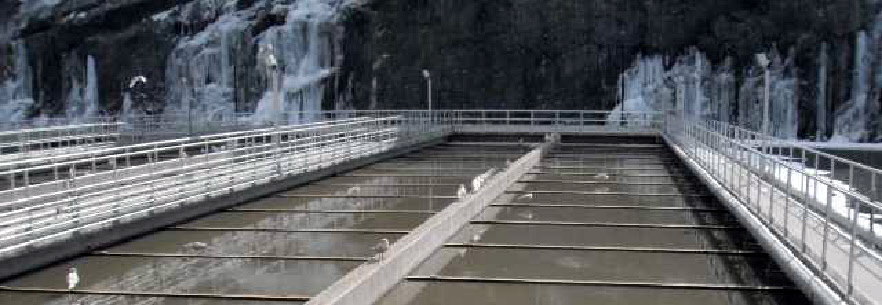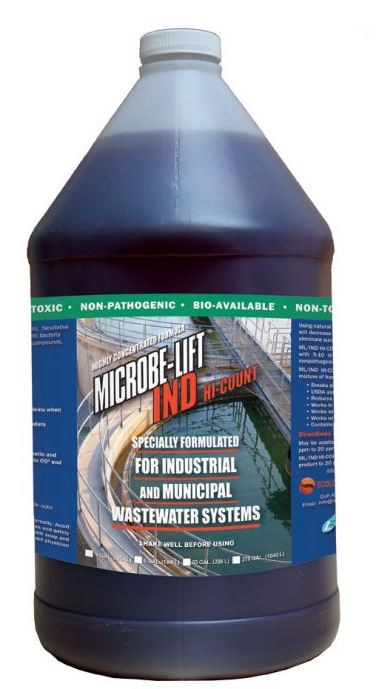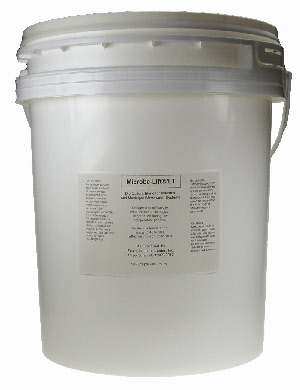
Efficient wastewater processes are highly dependent on cultivating and maintaining a strong biological community which will break down and consume waste. As most wastewater plant managers and operators know, when the biological community is disrupted by toxins, chemicals, undissolved solids, fats, oils or greases, the breakdown does not take place as it should. That means the wastewater process is no longer working to full capability, if at all, and it means trouble and extra expense in energy and clean-up.

Benefits, such as demineralization, elimination of hydrogen sulfide and volatile fatty acid odours, increased reproduction of facultative anaerobes, carbon oxidation, nitrification, denitrification, dissolved oxygen, coagulation, flocculation, settleability,reduced BOD5, COD, TSS, TKN, TP, TPH and sludge volume index may all be found with beneficial bacteria biologicals or through efficient mechanical technologies or both.
Acadian Aquatic Systems , along with our network of partners, can provide scaleable solutions for commercial and municipal clients from design to system implementation and product selection and supply.
High-Content Industrial Wastewater Bacteria
Specifically formulated for industrial and municipal wastewater systems. Contains photosynthetic bacteria which limits algae growth through “competitive exclusion” and natural selective inhibition while also improving oxygen levels. Degrades a wide range of organic chemicals and odor-causing compounds, including those that contain sulfur, such as mercaptans and hydrogen sulfide.
Improves BOD and COD removal efficiency
– Accelerates recovery from upsets and shock loads
– Accelerates plant startups
– Significantly reduces odors in and around plant
– Improves solids settling
– Solves your most difficult waste management problems when used in a controlled maintenance program
– Reduces hydrogen sulfide which causes strong, offensive odors
– Reduces TSS
– Digests solid organic waste, grease, fats and oils
– Reduces organic dyes in textile plants
– Degrades hydrocarbons, halogenated aliphatic hydrocarbons, chlorinated aromatic compounds and chlorinated solvents into CO2 and water
– Reduces TPH and BTEX
– Expands plant capacity
– Helps establish or improve nitrification efficiency
– Improves cold weather operations
Comprises several biological strains. It is a special mixture of bacteria designed for a broad spectrum of applications.
– Breaks down cellulose
– USDA authorized for un use meat and poultry plants
– Reduces ammonia and organic nitrogen levels
– Works in a wide pH range
– Works with or without light
– Works with or without aeration
– Contains billions of aerobes and anaerobes
T ypical Application Rate: 3 PPM monthly
 Municipal & Commercial Wastewater Treatment Formula
Municipal & Commercial Wastewater Treatment Formula
Dry powdered blend with a 5.2 billion cfu/gram bacterial count. A cost effective bacterial additive for municipal and wastewater treatment plants. The wastewater treatment formula is a blend of naturally occurring organisms that attack the source – waste – as it enters the municipality system, preventing solids/sludge accumulation at pump stations, in sewer lines, and improving the plant efficiency. Plants decrease malodorous environment with improved BOD and efficient removal of solids.
APPLICATIONS : • Wastewater Treatment Plants • Composting Facilities • Leachates and Dumps • Food Processing Plants • Winery • Holding Tanks • Lift Stations • Oxidation Ditches • Activated Sludge • Lagoons
Municipal wastewater plants face the constant challenge of combating solids, sludge, malodors, organic buildup, and grease. These can be defined as undesirable levels of BOD, H2S, TSS, FOG, and poor DO stability. Municipalities face these challenges due to older, outdated facilities, which are over the designed capacity, along with a wide range of residential, commercial and industrial waste streams. The quick fix attempt of using chemicals or manual labor as wastewater treatment measures can be costly and inefficient.
Targeted Coumpounds : Phenols, Cellulose Material, Sludge Volume, Hydrogen Sulfide Odors, Proteins, High BOD, Ammonia, Foaming, Surfactants, Soaps, Starch, FOGs, BTEX, Chemicals
Aerobic and facultative anaerobic.
Contact us for pricing and information. Phone Toll Free 866-533-2863 or Email info@acadianaquaticsystems.ca
Custom Microbial Products
Contaminated Site Remediation
These highly concentrated, microbial solutions are suitable for all weights of petroleum hydrocarbons on sites including hydrocarbons and chlorinated hydrocarbons including solvents and other volatile organic compounds (such as trichloroethane, trichloroethene, benzene, toluene, ethylbenzene and xylenes, BTEX ) and fuels such as diesel or gasoline. Based on our microbes’ complex metabolic pathways they are thereby able to degrade complex hydrocarbon chains.
Food Processing Operations
Customized products for the food industry are designed to rapidly biodegrade unwanted wastewater components such as fat, oil, BOD5 , COD, TSS, TDS, TKN and other related organics.
Lakes, Ponds and Lagoons
Concentrated products are designed to degrade organic materials that collect in large bodies of water causing odours and algae. They are also used to treat wastewater systems, animal waste, septic tanks and seasonal/ portable toilets.
BWE MICROBIAL LINE
These microbial products are highly concentrated, naturally occuring marine micro-organisms that rapidly biodegrade organic wastes and grease, turning them into harmless water and carbon dioxide, and also control odour. Food processors (meat, poultry, dairy, oil and grain) use Bluewater Environmental Inc.’s microbial products to maintain efficient activity in wastewater treatment systems and waste lagoons and to control odour. At food service facilities and restaurants, our microbial products control odours and prevent problems in grease traps, pipes and drain lines.
PWE PB | BWE M1H | BSE950E
BWE 1200
The utilization of these facultative microbes for the treatment of hydrocarbon components in Soil, Groundwater or Lagoons will successfully degrade petroleum hydrocarbon contaminant such as BTEX, PHC F1-F4, and chlorinated petroleum hydrocarbons such as PCE, TCE, and DCE. Rapid degradation can take place in both the microbial Anaerobic or Aerobic phases. These microbial solutions have been, and are, providing successful treatment in major Petroleum and Petrochemical Process Plants in Canada.
APPLICATIONS: • Oil Spills/Fuel Spills • Tanks • Biopiles • Hazardous Wastes • Brownfields • Bioreactors • Abandoned Sumps • Landfarming • Oil Lagoons
Bioremediation is a technology that uses naturally occurring microorganisms to degrade hazardous organic substances into less toxic or non-toxic compounds such as carbon dioxide and water. The use of biological processes for the treatment and/or remediation of wastes are established methods for reducing the impact of both industrial and municipal pollutants on the environment. In any biological process, from septic systems to large-scale treatment plants, the fundamental component is bacteria. As such, effective management of the existing biological population is essential to the proper operation of these systems.
Bioremediation can be divided into two categories: intrinsic and augmented.
Intrinsic remediation relies on bacteria that are already present in the soil to consume contaminants. This technique involves stimulating bacteria to consume the target contaminants with an electron acceptor – either oxygen, sulphate or nitrate – and a mix of nutrients to support bacterial metabolism.
Augmented biorernediation or bioaugmentation utilizes a consortia of bacteria that are selected for their ability to degrade specific contaminants. The bacteria are introduced into the contaminated area and their metabolism is supported with added nutrients and electron acceptors.
Bioaugmentation provides a much faster clean-up than intrinsic bioremediation. Adding large populations of proven hydrocarbon degrading bacteria greatly accelerates the bioremediation process. Conversely, intrinsic bioremediation req uires a substantial lag period for the indigenous bacteria to buildup a population that is capable of degrading contaminants to acceptable levels. This degradation is accomplished through in-situ (in place) or ex-situ (off site) bioremediation techniques.
In order to achieve accelerated or super-degradation of organic compounds there must be at least 1,000,000 hydrocarbon-degrading bacteria present per gram of contaminant. Once a site is pre-screened and it’s determined that our technology is suitable for that site, it is a virtual guarantee of a quick and successful clean-up. The following are some typical contaminants that can be treated:
APPLICATIONS: • Oil • Gasoline • PCBs • BTEX • Diesel • Paraffin • Asphaltenes • Pesticides • Herbicides • Fungicides
ODOUR NEUTRALIZATION
Bio/Scent™ and the Evane/Scent™ Odour Neutralization Systems have been installed throughout North America regardless of temperature or climate. The preferred system for cold climates, Evane/Scent™ Waterless Vapour Neutralization System, provides full, year round operation without the risk of freezing. The regenerative blower discharge passes warm air through the essential oils chamber releasing only the odour neutralizing vapour through a flexible hose and a series of polypropylene fittings and specialty nozzles. It is used on all indoor and outdoor applications and will not freeze or leave an overspray on walkways, personnel or plant equipment. Systems are available for lease, rental or purchase.
APPLICATIONS: • Landfills • Compost • Transfer Stations • Bins • Trucks • Wastewater Lagoons • Meat Processing
SOLID WASTE MANAGEMENT
Nuisance odours are a common problem in solid waste management. Microbial bacteria eliminates odours by influencing the microbiology of the decomposing waste in the substrate. The presence of microbes with non-odourous by-products is increased while the presence of microbes with odourous by-products is decreased. Microbial propagated facultative bacteria aggressively continue the decomposition process of organic matter while simultaneously eliminating the odour producing mechanism. Microbial bacteria can be applied to solid waste as a surface contact treatment or incorporated directly into the odour causing substrate.
APPLICATIONS: • Landfills • Compost • Transfer Stations • Bins • Trucks
Bacta-Pur® System
XLG – N3000 – H2000 – Pond- Industrial & Commercial Bactivators
The Bacta-Pur® System assures the presence of the optimal team for efficient and complete biodegradation of different organic compounds. The presence of optimal bacterial community helps stabilize plant performance including quick recovery from toxic shocks and wash outs and facilitates oxygenation. The Bacta Pur® System provides an optimal community of beneficial microbes to digest sludge. The Bacta Pur® System is recognized as a standard method to digest sludge in situ. This eliminates costs and energy of dredging and simply transporting the pollution elsewhere. Time, money & energy are saved as overall treatment is improved. The Bacta-Pur® System includes Bacta-Pur® N3000, community of nitrifying and denitrifying bacteria to eliminate toxic ammonia, nitrite and nitrate even under ice in sewage lagoons. The BACTIVATOR® grows and increases the number of bacteria and optimize their conditions. It allows continuous injection of active nitrifying culture in high concentration and optimal condition for efficient removal of ammonia, nitrite and nitrate.
APPLICATIONS: • Wastewater/Swers • Grease Traps & Interceptors • Lakes & Ponds • Aquaculture & Holding Tanks
